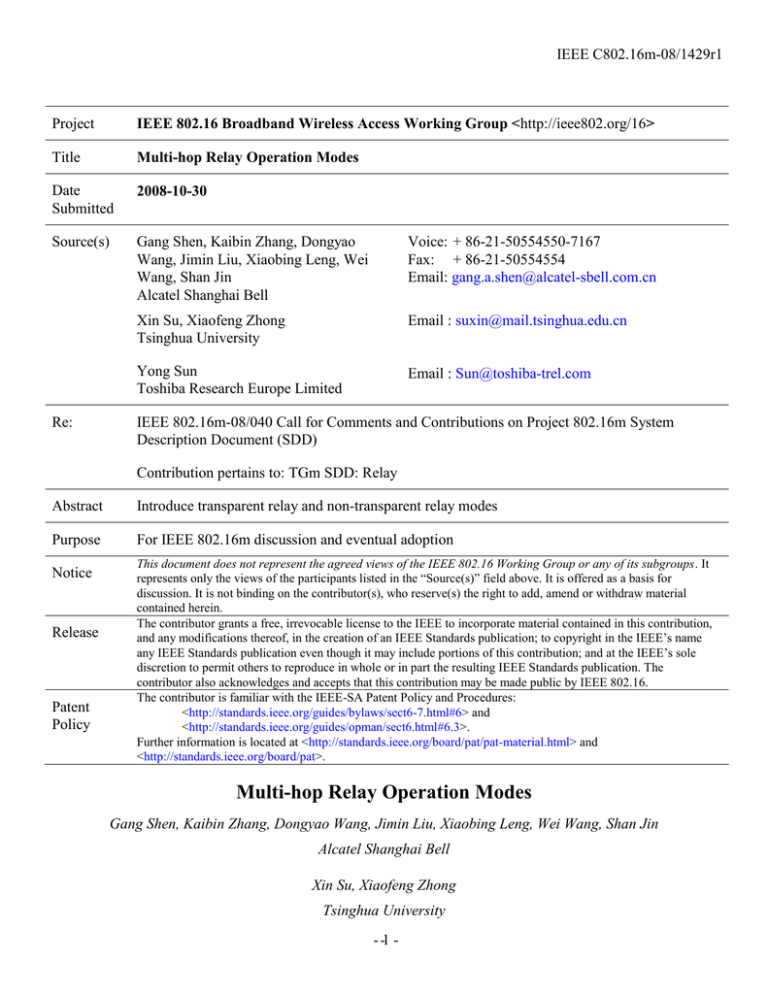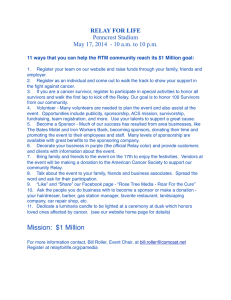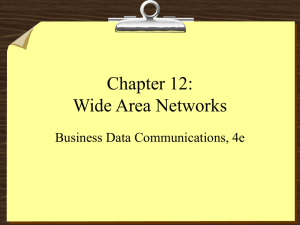IEEE C802.16m-08/1429r1 Project Title
advertisement

IEEE C802.16m-08/1429r1 Project IEEE 802.16 Broadband Wireless Access Working Group <http://ieee802.org/16> Title Multi-hop Relay Operation Modes Date Submitted 2008-10-30 Source(s) Gang Shen, Kaibin Zhang, Dongyao Wang, Jimin Liu, Xiaobing Leng, Wei Wang, Shan Jin Alcatel Shanghai Bell Voice: + 86-21-50554550-7167 Fax: + 86-21-50554554 Email: gang.a.shen@alcatel-sbell.com.cn Xin Su, Xiaofeng Zhong Tsinghua University Email : suxin@mail.tsinghua.edu.cn Yong Sun Toshiba Research Europe Limited Email : Sun@toshiba-trel.com Re: IEEE 802.16m-08/040 Call for Comments and Contributions on Project 802.16m System Description Document (SDD) Contribution pertains to: TGm SDD: Relay Abstract Introduce transparent relay and non-transparent relay modes Purpose For IEEE 802.16m discussion and eventual adoption Notice Release Patent Policy This document does not represent the agreed views of the IEEE 802.16 Working Group or any of its subgroups. It represents only the views of the participants listed in the “Source(s)” field above. It is offered as a basis for discussion. It is not binding on the contributor(s), who reserve(s) the right to add, amend or withdraw material contained herein. The contributor grants a free, irrevocable license to the IEEE to incorporate material contained in this contribution, and any modifications thereof, in the creation of an IEEE Standards publication; to copyright in the IEEE’s name any IEEE Standards publication even though it may include portions of this contribution; and at the IEEE’s sole discretion to permit others to reproduce in whole or in part the resulting IEEE Standards publication. The contributor also acknowledges and accepts that this contribution may be made public by IEEE 802.16. The contributor is familiar with the IEEE-SA Patent Policy and Procedures: <http://standards.ieee.org/guides/bylaws/sect6-7.html#6> and <http://standards.ieee.org/guides/opman/sect6.html#6.3>. Further information is located at <http://standards.ieee.org/board/pat/pat-material.html> and <http://standards.ieee.org/board/pat>. Multi-hop Relay Operation Modes Gang Shen, Kaibin Zhang, Dongyao Wang, Jimin Liu, Xiaobing Leng, Wei Wang, Shan Jin Alcatel Shanghai Bell Xin Su, Xiaofeng Zhong Tsinghua University - -1 1 IEEE C802.16m-08/1429r1 Yong Sun Toshiba Research Europe Limited 1. Introduction Two kinds of relay operation modes are discussed in the past IEEE 802.16m sessions, namely non-transparent relay and transparent relay mode. Each mode has its own advantages and corresponding usage cases. By relaying both control signaling and data traffic non-transparent relay works well for the coverage extension. With the separation of control and data, transparent relay is designed to assist 16m relay system in aspects of signaling latency reduction, facilitation of RS group, removal of intra-BS handover latency and etc. These two modes can co-exist in a relay network, and a MS should access the network through one of these two relay modes. It is suggested to design one unified multi-hop relay frame structure to flexibly support different relay operation modes. 2. Multi-hop Relay Operation Modes In transparent relay mode, a MS associated to a RS is located within the coverage of the BS. The control signaling from the BS can directly reach the MSs, while the data traffic is relayed via relay station, as illustrated in Fig.1. In this relay mode, the control signaling and the data traffic is separated. Transparent relay only supports centralized scheduling. BS coordinates and allocates the radio resources to MSs and RSs within the cell by distributing control information and arbitrating access requests. RS only has the functionality of forwarding UL traffic to BS and vice versa. Transparent relay is dedicated for throughput enhancement, where MS is located within the coverage of BS DL control channel. DL control information is always transmitted with the most robust modulation scheme which guarantees the highest possible reach. Conversely in non-transparent relay mode, as illustrated in Fig.2, all data and control signaling transmissions between BS and MS are relayed. The non-transparent RS can operate in both centralized and distributed scheduling. The non-transparent relay mode has the capability of extending the coverage. Transparent relay mode and non-transparent relay mode can coexist. It is suggested to design one unified relay frame structure to support both transparent relay mode and non-transparent relay mode. RS BS MS Data Control Fig.1 Transparent RS mode - -2 2 IEEE C802.16m-08/1429r1 RS BS MS Data Control Fig.2 Non-transparent RS mode 3. Transparent Relay Mode Non-transparent relay carries control signaling along the same path as that of data traffic. It does not always provide the best performance in all scenarios. The evident disadvantages may include the overhead of control signaling, the transmission delay of control messages and the frequent intra-BS handover. In the case that MS is located within the coverage of BS DL control channel, transparent relay is preferred to exchange the control signaling directly between BS in order to curb the performance inefficiency. BS DL control information is always transmitted with the most robust modulation scheme, and thus has the highest possible reach. Transparent relay has the following properties. Benefit RS grouping A RS may occupy one separate frequency partition for the data communication to the attached MS. However, free frequency partition is not always available for relay stations. An RS may be operated in a location where no free frequency partition allocation is possible due to interference from all other frequency partitions. RS may share the common frequency partition with its superordinate BS or other RSs, namely frequency partition sharing or RS group. Transparent relay is suitable for RS grouping, as only one coordinator (e.g. the superordinate BS) transmits control signaling within the RS group in the transparent relay mode. Other RSs do not transmit control signaling and only receive control signaling from the superordinate one. It facilitates the centralized control and scheduling for RS group. Conversely in non-transparent relay mode BS and RS are required to transmit each own control signaling. It may cause some difficulties in how to schedule these control signaling apart. For example, if the BCHs transmitted by different non-transparent RSs within one RS group starts at the same offset with respect to the beginning of the frame, it leads to strong interference for the decoding of control signaling. Low latency for control signaling Multi-hop communication causes forwarding latency, especially for control signaling exchanged between BS and MS. In the case where a MS can receive direct signaling from a BS, a direct link between the BS and the MS benefits for short control signaling latency, i.e. the DL control signaling is transmitted to the MS directly without processing and scheduling delay in RS. Taking UL bandwidth request as an example to depict the control signaling latency of transparent relay mode, when a BS gets the bandwidth request from a MS, it sends UL grant to the MS directly without any delay introduced by relaying. In comparison, in non-transparent relay mode the UL grant is firstly transmitted to the RS, and then it is forwarded to the MS. Thus a two-step procedure is required with extra delay introduced. Another example regarding UL HARQ is illustrated as follows. It is assumed to use the centralized scheduling. - -3 3 IEEE C802.16m-08/1429r1 The UL data traffic is transmitted from the MS to the BS via the RS. To response the reception of the initial transmission, the BS directly sends HARQ ACK/NACK to the MS in the transparent relay mode. Here at least one-frame latency is saved for HARQ ACK/NACK response in transparent relay mode. No intra-BS handover for MS In multi-hop relay networks, there are possibly many RSs deployed and each one has a small coverage. For a mobile MS, it may have frequent handover and interruption with the introduction of relay. For transparent relay, all MSs and RSs within a cell synchronize to and receive the control signaling from one coordinator, i.e. the BS. Thus, when a MS roams from a RS to another one within the same cell, it does not need to conduct resynchronization for intra-BS handover. What need to do is to change the data forward path. And the service is not interrupted during the procedure. Other properties There are some other properties and advantages of the transparent relay mode, such as less overhead of the control signaling due to one-step transmission from BS to MS. What’s more, centralized scheduling benefits high bandwidth efficiency especially in the case of the frequency partition sharing. 4. Summary Transparent relay mode and non-transparent relay mode have their own advantages and usage. For MS within BS coverage, it is better to use transparent relay. For the purpose of coverage extension, non-transparent relay works well. Transparent relay and non-transparent relay can co-exist in one network. Proposed Text for SDD [Insert the following text in the section 15 “Support for multi-hop relay”] ------------------------------- Text Start --------------------------------------------------- 15.x Relay mode Two different types of relay modes are defined, namely transparent relay mode and non-transparent relay mode. In the transparent relay mode, an MS receives the control signaling from the BS directly, while data traffic is forwarded by RS. In the non-transparent relay mode, both control signaling and data traffic are relayed along the same multi-hop path. These two modes can co-exist in a multi-hop relay network. One unified multi-hop relay frame structure should be defined to support both relay modes. ------------------------------- Text End --------------------------------------------------- - -4 4

